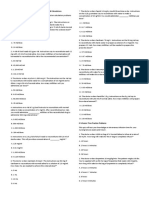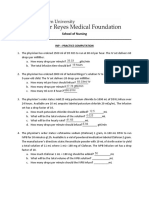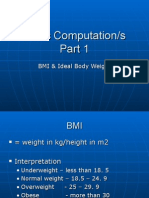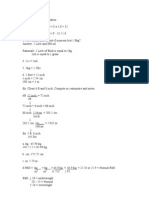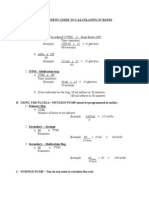0%(1)0% found this document useful (1 vote)
7K viewsIV Fluid Calculation
IV Fluid Calculation
Uploaded by
emyjonesThis document provides information and examples for calculating intravenous (IV) fluid infusion rates in milliliters per hour and drops per minute. It explains how to calculate the flow rate based on the total volume and time ordered by the physician. Common IV drop factors for macrodrips, microdrips, and specific medications are also listed, along with an example of how to calculate the drops per minute for a medication ordered to infuse over a certain time period. Proper techniques for setting up calculations are recommended to avoid medication errors.
Copyright:
Attribution Non-Commercial (BY-NC)
Available Formats
Download as PPTX, PDF, TXT or read online from Scribd
IV Fluid Calculation
IV Fluid Calculation
Uploaded by
emyjones0%(1)0% found this document useful (1 vote)
7K views7 pagesThis document provides information and examples for calculating intravenous (IV) fluid infusion rates in milliliters per hour and drops per minute. It explains how to calculate the flow rate based on the total volume and time ordered by the physician. Common IV drop factors for macrodrips, microdrips, and specific medications are also listed, along with an example of how to calculate the drops per minute for a medication ordered to infuse over a certain time period. Proper techniques for setting up calculations are recommended to avoid medication errors.
Copyright
© Attribution Non-Commercial (BY-NC)
Available Formats
PPTX, PDF, TXT or read online from Scribd
Share this document
Did you find this document useful?
Is this content inappropriate?
This document provides information and examples for calculating intravenous (IV) fluid infusion rates in milliliters per hour and drops per minute. It explains how to calculate the flow rate based on the total volume and time ordered by the physician. Common IV drop factors for macrodrips, microdrips, and specific medications are also listed, along with an example of how to calculate the drops per minute for a medication ordered to infuse over a certain time period. Proper techniques for setting up calculations are recommended to avoid medication errors.
Copyright:
Attribution Non-Commercial (BY-NC)
Available Formats
Download as PPTX, PDF, TXT or read online from Scribd
Download as pptx, pdf, or txt
0%(1)0% found this document useful (1 vote)
7K views7 pagesIV Fluid Calculation
IV Fluid Calculation
Uploaded by
emyjonesThis document provides information and examples for calculating intravenous (IV) fluid infusion rates in milliliters per hour and drops per minute. It explains how to calculate the flow rate based on the total volume and time ordered by the physician. Common IV drop factors for macrodrips, microdrips, and specific medications are also listed, along with an example of how to calculate the drops per minute for a medication ordered to infuse over a certain time period. Proper techniques for setting up calculations are recommended to avoid medication errors.
Copyright:
Attribution Non-Commercial (BY-NC)
Available Formats
Download as PPTX, PDF, TXT or read online from Scribd
Download as pptx, pdf, or txt
You are on page 1of 7
IV fluids
Emelda Jones, BSN, RN
Calculating milliliters per hour
MD orders type solution amount " time of
infusion
medications to be added
to continuous infusion
to intermittent infusion
(IVPB)
as bolus dose
Calculating milliliters per hour
Rx: 1000 ml NSS to run over 6 hours
total volume = ml/hour total time in hours
1000 = 166.6 ml/hr 6
Round off to 167 ml/hr
Calculating Drops per Minute
Rx: Administer 1000 ml How many ml will you
D5W every 8 hr. Drop add to 50 ml bag?
factor is 15 gtt/min 500 mg = 1g
total volume x drop 1 ml x ml
factor = gtt/min total 500 mg = 1000 mg
time (in minutes) 1 ml x ml
1000 ml x 15 = 15000 8
500 x = 1000
x 60 480
x = ml
= 31.25 gtt/min
Round to 31 gtt/min
Common IV Drop Factors
Macrodrip 10gtt/ml 15 How many drops per
gtt/ml 20 gtt/ml minute will you run the
Microdrip 60 gtt/ml Kefzol so it is absorbed
in 20 minutes?
Rx: Kefzol 1 g IVPB q 6 h
(Mix in 50 ml D5W. 50 ml X 20 (drop factor)
Infuse over 20 min.) = 20 (time in minutes)
Drop factor is 20 gtt/ml 1000 = 20
Kefzol supplied as Run at 50 gtts/min
500mg/ml.
Tips from Errickson & Todd
Write out units of measurement; must appear in same
order
e.g. 60 mg = 90 mg (60mg:1tab::90mg:x tabs) 1 tab x
tabs
line up decimals
Re-check if odd answer e.g. 25 tablets !!
Calculator only as good as your set-up
You might also like
- OB Math Calculation - Practice TestDocument5 pagesOB Math Calculation - Practice TestHussein DiabNo ratings yet
- IV Reconstitution Calculation ProblemsDocument5 pagesIV Reconstitution Calculation ProblemsAxel StoneNo ratings yet
- HESI Dosage Calculation Practice ExamDocument24 pagesHESI Dosage Calculation Practice Exambhilligoss35No ratings yet
- Care of The Patient With COVID-19 COVID Case Study 1Document3 pagesCare of The Patient With COVID-19 COVID Case Study 1Ashley HernandezNo ratings yet
- Insulin Sliding Scale ProtocolDocument2 pagesInsulin Sliding Scale ProtocolnashqonashNo ratings yet
- Practice ComputationDocument5 pagesPractice Computationnictan 14No ratings yet
- Practice Questions - Med MathDocument3 pagesPractice Questions - Med MathAlen Alano100% (1)
- Practice Dosage ExamDocument6 pagesPractice Dosage Examstarshine70006No ratings yet
- Dosage Calculation Course ReviewDocument2 pagesDosage Calculation Course Reviewsmpc9481No ratings yet
- Drug Calculations AssignmentDocument8 pagesDrug Calculations AssignmentBern NerquitNo ratings yet
- Calc Drip Rates 2Document2 pagesCalc Drip Rates 2Charisse Nicole DiazNo ratings yet
- Math Calculation InformationDocument19 pagesMath Calculation InformationAnonymous FmTb49No ratings yet
- Basic Computations 2 IV & IVFDocument37 pagesBasic Computations 2 IV & IVFCarl Elexer Cuyugan Ano100% (5)
- Drug Dosage and IV Rates CalculationsDocument6 pagesDrug Dosage and IV Rates CalculationsLorens Troy SoltisNo ratings yet
- Abbreviation and Drug FormulaDocument11 pagesAbbreviation and Drug Formulaapi-373991095% (21)
- Maternal+Newborn+Matrix+Packet+KEY Spr+2019+ (MR)Document6 pagesMaternal+Newborn+Matrix+Packet+KEY Spr+2019+ (MR)lisa mornoNo ratings yet
- Basic Drug Computations Part 1Document8 pagesBasic Drug Computations Part 1Carl Elexer Cuyugan Ano100% (4)
- Camporedondo, Bryan C. RLE8 - Group5 Emergency Drugs: Atropine SulfateDocument4 pagesCamporedondo, Bryan C. RLE8 - Group5 Emergency Drugs: Atropine SulfateIglesia Ni Cristo DoctorsNo ratings yet
- ComputationDocument11 pagesComputationenadseyer100% (1)
- Changing An IV SolutionDocument2 pagesChanging An IV SolutionNoel100% (9)
- Nursing Care Plan Sample For BeginnersDocument15 pagesNursing Care Plan Sample For BeginnersMoe KhanNo ratings yet
- Medical Surgical Nursing IIDocument52 pagesMedical Surgical Nursing IItwinkle143No ratings yet
- Pp2 AnswersDocument4 pagesPp2 AnswersDallis HodgsonNo ratings yet
- Drug CalculationsDocument3 pagesDrug Calculationsapi-3739910100% (4)
- Assisting With Thoracentesis: Skills Laboratory Module No. 6Document6 pagesAssisting With Thoracentesis: Skills Laboratory Module No. 6febie pachecoNo ratings yet
- Skills Drug ComputationDocument23 pagesSkills Drug ComputationFreida Michelle BonnitNo ratings yet
- Arthroplasty CareDocument3 pagesArthroplasty CareEmjhay Swakida100% (1)
- Emergency DrugsDocument47 pagesEmergency DrugsBesiman100% (1)
- Math Pre-Test QuestionsDocument4 pagesMath Pre-Test Questionsgok_addictedNo ratings yet
- Basic IV Therapy CalculationsDocument35 pagesBasic IV Therapy CalculationsRommel Israel100% (1)
- IVF ComputationDocument31 pagesIVF ComputationDuran JustineNo ratings yet
- What Is Basic IV Therapy TrainingDocument6 pagesWhat Is Basic IV Therapy TrainingJay Depakakibo GallardoNo ratings yet
- Pharma - Week 3 (Drug Calculations)Document5 pagesPharma - Week 3 (Drug Calculations)MIKAELA DAVIDNo ratings yet
- Medication Calculation Review 2009Document10 pagesMedication Calculation Review 2009sangkeny100% (2)
- Iando Monitoring: CHN Ii Clinical InstructorDocument55 pagesIando Monitoring: CHN Ii Clinical InstructorJoshua AysonNo ratings yet
- Medication - ALT-Template - Enoxaparin SodiumDocument1 pageMedication - ALT-Template - Enoxaparin SodiumNancyAmissahNo ratings yet
- Practice DosageDocument4 pagesPractice DosageDonna Mackin DeBiaseNo ratings yet
- Appendix 7 Surgical InstrumentsDocument49 pagesAppendix 7 Surgical InstrumentsMicaila MacyNo ratings yet
- Formulas and DripsDocument6 pagesFormulas and DripsJsohna BelinaNo ratings yet
- Drugs CalculationsDocument5 pagesDrugs CalculationsJoy HavsonNo ratings yet
- Nursing Skills Computation Part 1Document2 pagesNursing Skills Computation Part 1Rose Ann100% (1)
- Dosage & CalculationsDocument20 pagesDosage & CalculationsKnight-Zussette VillarNo ratings yet
- IVDocument2 pagesIVCee SanchezNo ratings yet
- IV Drip Rate CalculationsDocument3 pagesIV Drip Rate CalculationsMimi DenilaNo ratings yet
- Practice Questions (F & E)Document5 pagesPractice Questions (F & E)pbiluanNo ratings yet
- Care of Indwelling or Foley CatheterDocument2 pagesCare of Indwelling or Foley CatheterNicole Marin-ChingNo ratings yet
- Calc IV Flow RateDocument1 pageCalc IV Flow RateAmyNo ratings yet
- The Ride of Your Life: What I Learned about God, Love, and Adventure by Teaching My Son to Ride a BikeFrom EverandThe Ride of Your Life: What I Learned about God, Love, and Adventure by Teaching My Son to Ride a BikeRating: 4.5 out of 5 stars4.5/5 (2)
- NURSING CARE OF ADULTS II: Passbooks Study GuideFrom EverandNURSING CARE OF ADULTS II: Passbooks Study GuideNo ratings yet
- COMPREHENSIVE NURSING ACHIEVEMENT TEST (RN): Passbooks Study GuideFrom EverandCOMPREHENSIVE NURSING ACHIEVEMENT TEST (RN): Passbooks Study GuideNo ratings yet
- IV Fluid ComputationDocument2 pagesIV Fluid ComputationRam August100% (1)
- Computation of Drug Dosage: WhereDocument4 pagesComputation of Drug Dosage: WhereMac Cristian A. Caragan50% (2)
- Sumaoang C. - Exercise No. 1 - Follow UpDocument3 pagesSumaoang C. - Exercise No. 1 - Follow UpBogartNo ratings yet
- Medication Administration p2Document12 pagesMedication Administration p2api-300218860No ratings yet
- Med CalculationsDocument3 pagesMed Calculationscistrans1994No ratings yet
- ExamplesDocument4 pagesExamplesJUBE-AN UDDIN CALBINo ratings yet
- Computation of Drug Dosage: WhereDocument4 pagesComputation of Drug Dosage: WhereTedd CamilingNo ratings yet
- IV ComputationDocument11 pagesIV ComputationSheniel Variacion100% (1)

